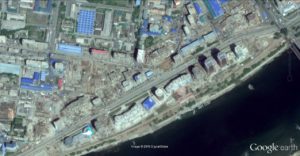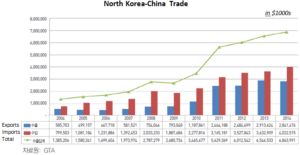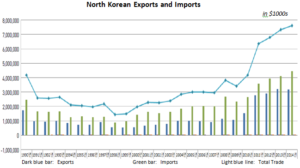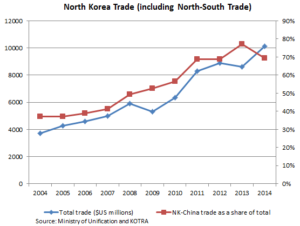
Pictured above (Google Earth): The Mirae Scientists Street under construction (2015-5-20)
According to the Korea Times:
North Korea has invested about 10 billion won in North Korean currency creating a big housing precinct for scientists in Pyongyang, Yonhap reported Thursday.
The Korean Central News Agency said the communist regime had spent about 9.9 billion won on 19 buildings to house 2,584 households and commercial and public facilities.
The first phase was completed on April 15, the birthday of late North Korean leader Kim Il-sung. Phase two was finished on the 70th anniversary of the founding of the North Korean Workers’ Party on Oct. 10.
Leader Kim Jong-un was quoted as saying the new street reflects the “love for people, respect for people and politics that puts people first” of the North Korean Workers’ Party.
For what it is worth KPW9.9 billion is approximately US$1.237 million on the black market, which comes to just $478/household assuming they each got an individual unit.
However, I would not get to hung up on these numbers, I cannot find any story in KCNA on the cost of Mirae Scientists Street, so until I hear an official estimate, I am going to put an * next to these numbers.
Here is what KCNA had to say about Kim Jong-un’s tour of the recently completed Mirae Scientists Street:
Pyongyang, October 21 (KCNA) — Kim Jong Un, first secretary of the Workers’ Party of Korea, first chairman of the National Defence Commission of the DPRK and supreme commander of the Korean People’s Army, went round Mirae Scientists Street, which was successfully completed as a model of Juche-oriented architecture and fairy street in the era of the Workers’ Party.
Feasting his eyes on the street, he said the longer one watches it, the more magnificent and spectacular it looks. He noted with pleasure that it proves visually the idea of the Workers’ Party of Korea of attaching importance to science and talents, it is a fashionable street of perfect combination of the Juche character, national identity, originality and formative art and unique one of our style which appeared in the capital city of Pyongyang as an icon of cultural efflorescence.
He said it is something unimaginable to build a street with flats for thousands of families and more than 150 public catering outlets in a matter of just one year by the existing method of construction. He noted with excitement that the completion of Mirae Scientists Street convinces everybody that the appearance of the country would undergo beyond recognition a decade later as everything is done in just one year instead of ten years.
Going round different places of the street, he learned in detail about the construction.
He said that it is fantastic, indeed, to watch the tower symbolic of the 53-storied skyscraper which has been built like an electronic track so that one may know it is Mirae Scientists Street even from distance, adding that formative art was applied to all the buildings at a very high level.
He was pleased that the flats have been constructed at the best quality and teachers and researchers would need to bring with them only hand luggage as their drawing rooms, parents’ rooms, rooms for couples, children’s rooms, kitchens, etc. are fitted with high-quality furniture and fixtures,
Hearing officials say foreigners will hardly believe that ordinary educators and scientists of the country will live free of charge in such deluxe apartment houses in the street on the picturesque bank of the Taedong River, he said that it is the advantages of the socialist system in the DPRK which capitalist countries can neither imitate nor build.
He praised the builders for having built all kinds of public catering and cultural and welfare establishments on the ground floors of the buildings in an impeccable manner to meet requirements of settlers.
He noted with appreciation that resting places and sporting parks have been built in a peculiar style so that residents might have good rest and do sports and greening in the residential area and the project for reinforcing banks of the river were done very well.
It is the steadfast will of our party to consolidate the foundation of socialism by dint of science and advance socialism with the power of the engine of science, he said, stressing the need to steadily increase substantial investment in the scientific researches on the basis of the successes and experience gained in the work for consolidating the material and technical foundations of different scientific research bases and improving the living standard of the scientists and researchers in recent years.
All the buildings of the street spruced up at a speed unprecedented in the history of construction are laudable structures of Songun Korea built by our service personnel and people with the will to create everything dear in their own style by their own efforts at a lightning speed, optimistic about the future, and they are valuable crystal of their patriotism, he said, extending thanks to the units of the Korean People’s Army and other units which participated in the construction, builders and helpers in the name of the Workers’ Party of Korea.
He expressed expectation and belief that all the builders would give fullest play to the inexhaustible mental power displayed in the construction of Mirae Scientists Street and make a positive contribution to turning Pyongyang City into a hub of Songun culture and the most magnificent and fashionable city of the world fame in all aspects and building the socialist country into a highly civilized nation.
He gave an instruction on inaugurating the street.
He was accompanied by Hwang Pyong So, Kim Ki Nam, Kim Yang Gon, O Su Yong, Jo Yong Won and Ma Won Chun.
Read the full story here:
N. Korea pours 10 billion won into street for scientists
Korea Times
2015-10-22




